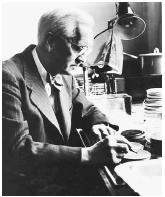Alexander Fleming
SCOTTISH BACTERIOLOGIST
1881–1955

Alexander Fleming will always be remembered for turning a laboratory mishap into one of the great medical discoveries of the twentieth century. His discovery of penicillin in 1928 laid the foundation for modern antibiotic therapy and earned him a share of the 1945 Nobel Prize in physiology or medicine.
Fleming was born on August 6, 1881, at Lochfield near Darvel in Ayrshire, Scotland. He attended elementary and secondary school in Scotland and then moved to London to attend the polytechnic school. He graduated with distinction in 1906 from St. Mary's Medical School, London University, received a graduate degree in bacteriology from St. Mary's in 1908, and lectured there until 1914. After serving as a captain in the Army Medical Corps during World War I, Fleming returned to St. Mary's in 1918.
Throughout his career Fleming was intensely interested in naturally occurring antibacterial substances, and penicillin was actually the second antibiotic that he discovered. In 1922 he described the antibacterial properties of lysozyme, a substance found in egg whites, mucus, and tears, which lysed, or dissolved, certain bacteria. Fleming found that lysozyme could turn a thick, milky white suspension of bacteria into a clear solution in a matter of seconds.
Unfortunately, lysozyme failed to destroy bacteria that caused human diseases and was never used as a medicine. Despite the limited utility of lysozyme, Howard Florey and Ernst Boris Chain of Oxford University later determined both its structure and the mechanism by which it destroys bacteria. These two scientists would figure prominently in Fleming's greatest discovery: penicillin.
Fleming freely admitted that he was not looking for a new antibiotic when he discovered penicillin in 1928. In fact, he was working on a problem unrelated to antibiotics when he returned to his lab from a month-long vacation and observed that a blue mold, or fungus, had grown on a discarded culture plate of Staphylococcus aureus (a common bacteria that causes many diseases in humans). Fleming further observed that a bacteria-free zone had developed around the mold. The once thick cultures of bacteria near the mold had become translucent, or almost clear, and evidently a substance produced by the mold had diffused through the culture medium and killed the bacteria.
The extraordinary appearance of the bacteria-free zone interested Fleming, so he set out to isolate the mold in pure culture and to determine some of its properties. Fleming classified the mold as Penicillium rubra, hence, the name penicillin for the active substance.
Fleming tested the purified mold against other bacteria and observed that some bacteria grew right up to the mold, while others grew only to within a few centimeters of it. He tested other molds for their ability to kill sensitive bacteria and found none. Fleming then grew the mold in a liquid medium and determined that the mold excreted penicillin into the culture medium. When he tested the medium against common bacteria, Fleming found that the growth of many disease-causing bacteria was inhibited. He even injected the medium into mice and observed no toxic effects from the new substance.
Although Fleming was convinced that penicillin had enormous potential value in medicine, he was unable to produce enough of it to demonstrate its value to the medical community. He published his findings in 1929, and penicillin seemed destined for obscurity. But in 1938, Florey and Chain began to reinvestigate penicillin and eventually produced enough pure material to demonstrate that Fleming's assertions were correct. Penicillin has indeed had enormous value in the treatment of infections worldwide.
SEE ALSO Antibiotics ; Penicillin .
Thomas M. Zydowsky
Bibliography
Internet Resources
"The Nobel Prize in Physiology or Medicine 1945." Available from http://www.nobel.se/medicinelaureates/1945/press.html .
"Penicillin, the Wonder Drug." Available from http://www.botany.hawaii.edu/faculty/wong .
"Sir Alexander Fleming—Biography." Available from http://www.nobel.se/medicinelaureates .
Comment about this article, ask questions, or add new information about this topic: